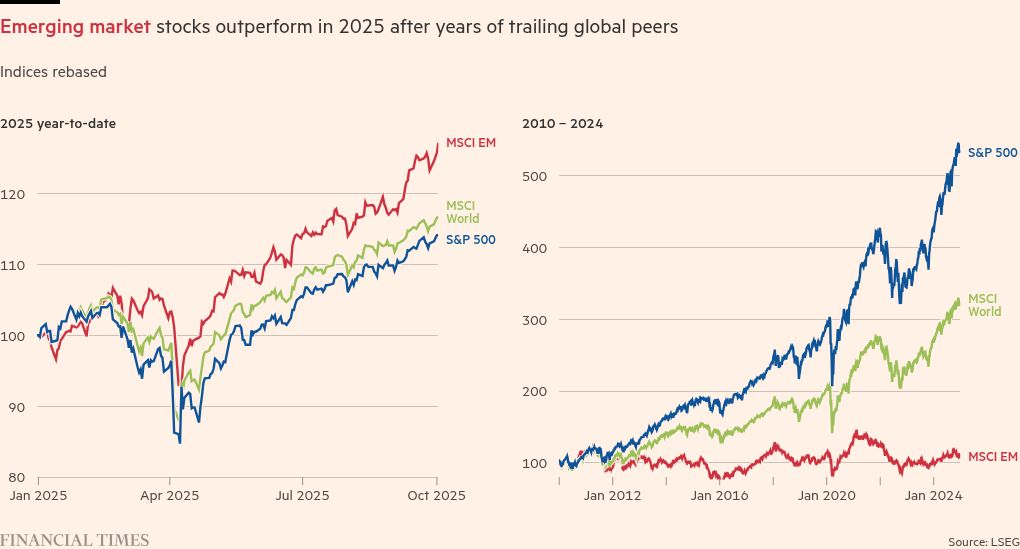Unlock the Editor’s Digest for free
Roula Khalaf, Editor of the FT, selects her favourite stories in this weekly newsletter.
Investors are snapping up assets across the developing world as a sliding dollar and bargain valuations fuel the biggest rally in emerging market stocks in more than 15 years.
An MSCI benchmark index of emerging-market stocks has risen 28 per cent so far this year, its biggest gain over the same period since 2009, while a JPMorgan index of government bonds sold by developing countries in their own currencies is up 16 per cent, in a growing comeback from a “lost decade” in the shadow of US markets.
The rally in emerging market stocks has far outpaced gains in advanced economies — an MSCI index of developed market stocks is up less than 17 per cent so far this year.
It marks a striking turnaround from the previous decade and a half. Emerging market stocks massively underperformed one of the greatest US bull runs in history between 2010 and 2024, with the MSCI index gaining less than 9 per cent over that entire period after a post-2001 rally collapsed into cycles of boom and bust.
“After 15 years of very mediocre performance, the stars are finally aligning, and the most important variable there is the dollar,” said Ian Simmons, senior portfolio manager at Fiera Capital. “Whether it is by design or accident, [US President Donald] Trump does seem to have engineered a weaker dollar.”
A weak dollar usually eases financial conditions in developing countries, by making it cheaper to service dollar-denominated debts. The Federal Reserve’s shift to cutting US interest rates has also supported dollar-funded bets on local currency bonds that have relatively high yields when adjusted for inflation.
About half of this year’s return in the JPMorgan domestic bond index has been due to FX moves, said Damien Buchet, chief investment officer of Principal Finisterre.
“Central banks are in easing mode and the dollar remains on a weakening trend,” he said.
Real yields have stayed aloft because central banks in bigger emerging markets such as Brazil and South Africa have been cautious about cutting interest rates this year, while poorer nations or those with fragile balances of payments such as Turkey have kept rates at double digits to attract capital.
Even in Asian economies such as Thailand and Malaysia with low interest rates, falling inflation has kept domestic bonds relatively attractive for local investors.
The rally in local currency bonds — their biggest since 2016 — has continued despite another brewing debt crisis in Argentina, once a classic emerging market trade that is now well off the radar of most global investors.
Across 17 large emerging markets outside China, local currency government bond issuance has hit a record $286bn this year to tap investor demand for high yields, said Zahabia Gupta, head of emerging markets credit research at S&P Global Ratings.
Equity investors are also extending the global frenzy for bets on AI into emerging markets that dominate the production of chips, defying warnings that AI demand may ultimately fail to match the boom in investment.
Korea’s Kospi stock index and Taiwan’s Taiex both hit record highs in the past few days as investors increased their bets on makers of chips, power equipment and other goods essential for AI data centres.
The stock market value of Taiwan Semiconductor Manufacturing Company, the world’s biggest chipmaker, has risen so much that its shares now make up about 11 per cent of the MSCI benchmark, more than the stocks of most other countries.
One fund manager said the revival of investor interest in emerging markets reflected “the dusk of US exceptionalism, with the US behaving much more like an emerging market itself” through erratic and volatile policymaking.
“When you have many of the traditional characteristics of EM coming out of the biggest [developed] market, people are looking elsewhere,” they added.
Many of this year’s gains in emerging market stocks have been due to “re-rating”, or boosts to their valuation as the ratio of their price to projected company earning increases.
On this basis, they are still cheap relative to US stocks. Shares in the MSCI benchmark are priced at about 14 times their forecast earnings for the next year, compared with about 23 times for the S&P 500.
“What has driven emerging-market performance year to date is re-rating — there is a big valuation gap between the US and the rest of the world. That gap is still substantial because US equities have been very expensive for a long time,” said Vivian Lin Thurston, portfolio manager at William Blair.
Indian stocks have been a high-profile laggard in the emerging market rally, partly because their prices had already risen enough to make them almost as expensive as US stocks, just as corporate earnings have fallen short of expectations.
Despite this year’s blistering performance elsewhere in emerging markets, investors said that overall flows to EM stocks and bonds are still lagging the rally. “It’s currently very underowned and underallocated,” Simmons said.
Data visualisation by Ray Douglas



